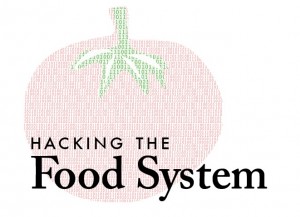[Hacking the Food System is an online conversation exploring how technology, information and data can change the food system status quo. Read past contributions, or new ones as they are posted on Food+Tech Connect on Tuesdays. You can also follow on Twitter (hashtag #foodtech), or Facebook.]
 For decades, “technology” in agriculture has meant machines and chemicals – bigger combines, stronger pesticides, and now, genetically engineered seeds. This is the technology – millions of farmers, academics, multi-national companies and development groups have come to believe – that will make farms more efficient, more productive and more cost effective.
For decades, “technology” in agriculture has meant machines and chemicals – bigger combines, stronger pesticides, and now, genetically engineered seeds. This is the technology – millions of farmers, academics, multi-national companies and development groups have come to believe – that will make farms more efficient, more productive and more cost effective.
But as we know, that story is not panning out as planned. Chemical fertilizers have depleted soil, herbicides created superweeds, and monocropping is documented to have lower overall yields than diversified farms. And cost effective? The vast majority of farming households earn their living off-farm.
Now, “technology” based on the sharing of information – data extracted from all points along the food chain – is helping to create a more transparent, equitable, and environmentally sound food system, and could save farmers and consumers money. It is information technology to inform us as consumers, as farmers and ranchers, as distributors and processors, and to assist us all in making better decisions. But thus far, “information technology” remains focused primarily on a very narrow set of needs, and much opportunity remains.
The multitude of responses we received at Food+Tech Connect to answer the question: how can information and technology be used to hack the food system? is a testament to the passion, insight and commitment of our community toward using technology to improve our food lives. Consumer applications to help families cook better meals, discover healthier foods in the market place, and trace our foods back to their source are making amazing, and rapid, progress.
And yet much less work is being done outside of the world of consumer applications and websites. Few technological resources exist to enable farmers to sell directly to consumers (aside from their own personal websites) and even less attempt to figure out the nitty-gritty logistics of the broken distribution chain. Organic farming research is scattered throughout the web and remains difficult for farmers to quickly and easily access. And the use of information and technology to better understand and improve food systems in developing nations are scarce.
Of course there are notable exceptions. Technology is beginning to help rural farmers in Africa predict weather and make farm improvements based on data; researchers are studying ways to use GPS data to make high intensity grazing more efficient. Several groups are attempting to work through the distribution quagmire, and cell phone use to deliver market data in developing nations is becoming more commonplace. Open Source Ecology is developing a “Global Village Construction Set,” and farmers too are posting their own ideas online, like Sugar Mountain Farm’s blueprint for an ecologically sound (and truly cost efficient) slaughterhouse.
But this dichotomy remains one of the biggest issues for food+tech. Scared of the “technology” which sold farmers half a million dollar grain silos, roundup ready corn, and the ability to confine thousands of hogs in a single facility, many farmers, ranchers and academics in the “good food movement,” are wary. “We just prefer real face to face time,” a meat processor recently told me when asked what kinds of technology he uses to conduct business. “We do our processing by hand.”
Luckily we are not talking about replacing face time with twitter or bringing in “efficient” machines to streamline processing. Yet in order to really disrupt the system, to hack it into something we have never seen before, it is those farmers, academics, processors and distributors we have to reach. The food+tech movement needs their knowledge of what is wrong with the system in order to revolutionize how it is we do business. And we need to encourage our best and brightest to tackle the big issues of the day, and to collaborate and to support one another as a movement and not purely as individuals.
While off to a good start, we have an excitingly long way to go to truly “hack the food system.” But it is a journey filled with innovation and opportunity. Perhaps our greatest resource as a movement is that we are here for the long haul, and the bulk of those involved are young, brilliant and eager.
Related articles
- Ellen Gustafson on Hacking the Food System: Eat Your Veggies (foodandtechconnect.com)
- Karl and Cara Rosaen on Hacking the Food System: Find Food and Feel Good (foodandtechconnect.com)
- Carl DiSalvo on Hacking the Food System: Reinvent Ag-Tech (foodandtechconnect.com)
- Anthony Nicalo on Hacking the Food System: Eliminating Information Asymmetry (foodandtechconnect.com)
- Elizabeth McVay Greene on Hacking the Food System: Farm Profitability and Affordability of Food (foodandtechconnect.com)
- Jamie Leo on Hacking the Food System: Hack Your Diet (foodandtechconnect.com)
- Emilie Baltz on Hacking the Food System: Story Corps for Food (foodandtechconnect.com)




